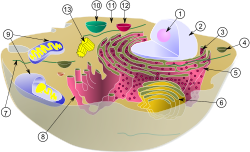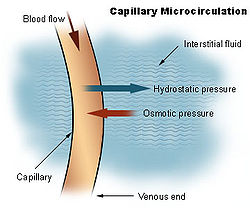Body fluids
The majority of the human body is composed of fluids and predominantly water. The value of the body fluids accounts for the 60-65% of the total body weight averaging between 42 and 46 L in a normal 70kg body. The body fluid component of the human body divides in two major compartments, the intracellular compartment which is the largest and the extracellular compartment which accounts for the half of the intracellular value.
Intracellular compartment[edit | edit source]
The intracellular compartment accounts for 28 L, the 2/3 of the total body weight. The intracellular fluid refers primarily to the fluid that is bound within the cellular plasma membrane called the cytosol. Besides cytosol however, there is also a small amount of fluid inside the cell that is not bound within the plasma membrane but rather by the organelle membrane. For example all the membranous organelles including the nucleus which surrounded by the phospholipid bilayer also contains fluid. Since each membrane bound compartment has different function between one another, the concentration and the composition of the intracellular fluid is also different and heterogeneous even within one cell.
Extracellular compartment[edit | edit source]
The extracellular compratment accounts for 14 L, the rest 1/3 of the total body weight. The extracellular fluid refers to all human body fluids apart from the intracellular compartment fluid and separates in three subdivisions: the blood plasma, the interstitial fluid and the transcellular fluid.
Blood plasma[edit | edit source]
Blood plasma is the non cellular portion of blood that consists of 98% of water, electrolytes and proteins. It accounts for the 55% of the total blood volume and averages between 2.5 and 3 L in each body.
Interstitial fluid[edit | edit source]
Interstitial fluid is a solution that bathes and surrounds the cells of the body. It is the site where exchange of nutrients and metabolites occurs between cells and capillaries.
Transcellular fluid[edit | edit source]
Transcellular fluid is the portion of total body water contained within epithelial lined spaces and is the smallest component of extracellular fluid and accounts for about 2.5% of the total body water.
| Trancellular fluids | ||
|---|---|---|
| Aqueous humour | Bile | Pleural fluid |
| Blood serum | Saliva | Breast milk |
| Cerebrospinal fluid | Sebum (skin oil) | Earwax |
| Endolymph | Semen | Female ejaculate |
| Sweat | Gastric juice | Mucus |
| Tears | Peritoneal fluid | Urine |
| pericardial fluid | Vaginal lubrication | Vomit |
| Vitreous humour | Perilymph |
Links[edit | edit source]
Bibliography[edit | edit source]
- HALL, John E. – GUYTON, Arthur C. Guyton and Hall Textbook of Medical Physiology. 12. edition. Saunders/Elsevier, 2010. ISBN 1416045740.
- Lecture Notes: Prof. MUDr. Jaroslav Pokorný DrSc.



